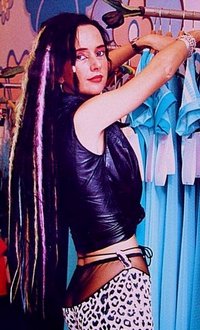Inventor of Clothes
 Desiree Webers was formally trained as a graphic designer. Although she went to artschool for a short while and had some fashion-technical training, she considers herself mainly as self-taught. She always tries to find new solutions for technical and functional problems. As a child she wanted to be an inventor. She started making clothes as soon as she was big enough to operate her mother’s sewing-machine. As a graphic school student she supported herself by supplying shops with her selfmade fashion. Her very short career as a graphic designer was long enough for her to understand she needed more freedom of expression. She went to art-school, fashion department, to study fashion design, but soon found out the teachers couldn’t teach her anything new. Afterwards she learned to draw patterns at a technical fashion school. Then she was ready to call herself fashion designer or: inventor of clothes.
Desiree Webers was formally trained as a graphic designer. Although she went to artschool for a short while and had some fashion-technical training, she considers herself mainly as self-taught. She always tries to find new solutions for technical and functional problems. As a child she wanted to be an inventor. She started making clothes as soon as she was big enough to operate her mother’s sewing-machine. As a graphic school student she supported herself by supplying shops with her selfmade fashion. Her very short career as a graphic designer was long enough for her to understand she needed more freedom of expression. She went to art-school, fashion department, to study fashion design, but soon found out the teachers couldn’t teach her anything new. Afterwards she learned to draw patterns at a technical fashion school. Then she was ready to call herself fashion designer or: inventor of clothes.
Form and Content
Nowadays most fashion design is nothing more than styling. Styles from the past are copied, maybe slightly altered, and then presented as brandnew. Retro styles dominate the fashion market for a long time now. Why do people wear these replica’s of past styles? What do they want to communicate? Are they anxious about their status and do they want to pretend they have style? Desiree Webers has always been interested in (non-verbal) communication. At graphic school she learned to present the message in a functional and seductive form in order to communicate succesfully. As fashion designer she never regarded fashion as pure formal design: there is always content, a reason why the form is designed like it is. She has certainly never been interested in presenting retro styles to cure social insecurity. Clothes can be so much more interesting and fun!
Concepts
A classic example of her conceptual approach to fashion design is the zipper-dress Desiree Webers designed more than 10 years ago. Because of it’s timeless quality it’s still in production. On first glance it’s a simple dress, but because of the 2 zippers it can be transformed into countless varieties:
The zippers run from the bottom front over the shoulders to the bottom back and have more runners. It’s possible to make splits and openings halfway giving the woman who wears it the opportunity to reflect her mood with her dress, giving signals by playing with her zippers. The zipper series exists of short and long dresses, short and long skirts, garter belts, tops; in leather or pvc.
Sex
People may think they are rational and civilised and that they communicate by speech and writing, but below the surface they are animals, driven by instinct and communicating with their bodies. Since we are animals with clothes on (at least most of the time!), our body-language can be boosted by wearing the right outfit. Uniforms for the police and army, power-suits for the business world, cult gear for the various youth tribes. And the main instinct that unifies us, that keeps mankind alive, is sex. Flirting can be much more succesfull when you wear the right clothes, which accentuate your nice parts and camouflage your maybe not so nice parts. Flirting is also a game of attraction and repulsion. Versatile clothes, with parts that can be opened and closed on strategic places, can be really usefull to play the game. Suggestion is a powerfull ‘weapon’, because it fuels the imagination, like wearing no underwear under half-transparant clothes. Humour can also be very sexy, because it relaxes, disarms and opens the mind for new possibilities.
Humour and Surrealism
Just like sex, humour transcends everyday reality. It brings us in a state where normality is mysterious and funny. Humour is also a great unifying force: it breaks social and cultural boundaries and brings people together. Why then are there so few designers who put a little humour in their designs? No sense of humour? Apparently most designers just want to design pretty clothes. It takes an artistic approach to conceptualise fashion design and transform mere clothes into something else. A vehicle for the imagination, a view of something totally unexpected. Isn’t it much nicer to be surprised by something wonderful than to be surrounded by predictable boredom all the time?
Freedom
All along her career Desiree Webers never cared for the conventions of the fashion industry. She did what she liked to do, never minded trends, being ahead of trends all the time. But when she started to explore the erotic theme ‘normal’ fashion shops declined. She had to switch to erotic shops. But freedom there was also limited because sex is serious business for these shops. They finally couldn’t handle the humour and imagination of her designs. So there was no other solution left than to start her own shop. A shop beyond all categories, ignoring conventions of fashion-, erotic- and clubwear-shops. Webers Holland was born.


















































